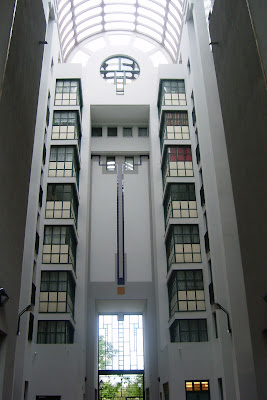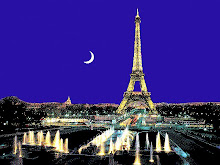Who can still afford...?
Labels :
Green Tower,
Paris 17,
Paris architecture
Who can still afford to have a house or an apartment in bigger cities is certainly an issue. Paris is not the most expensive city in the world, but it’s expensive enough. Unless you already have a fortune, you need a good income - very often at least two family members would need to have a job - if you wish to find an acceptable place for your family (buying or renting).
Some efforts, maybe not sufficient, are made in order to offer not only luxury lodging within the Paris city limits. There are laws and regulations which force the French municipalities to take the social aspect into account when allowing new building permits – more or less followed.
Where I live in Paris, the population is still quite well mixed. Most buildings are hundred years or older, but some fifteen minutes walking away we can find some examples of what has been done with regard to new constructing these last ten years. The buildings I show here are basically occupied by people who I suppose have a comparatively modest income. They have partly been built on what used to be a rail yard.
It seems to me that here the architects have at least tried to do something a little bit different and to create something which may seem acceptable for a decent living. Between the buildings, you can also find some green areas, playing grounds etc. … and you are still in Paris, not in a more or less far away situated suburb.
The surprising “green tower” building is actually very simple as such and without the pots on the balconies it would look extremely ordinary, but it's already some ten years old and the plants are still there and green (or almost all of them). However, what will it look like in another ten or twenty years? It’s clear that the Paris city buildings from e.g. the 19th century were made to last “for ever”. How long will these buildings still be nice? Maybe a necessary compromise? You build something really nice to be there "for ever" and then it gets too expensive.

Some efforts, maybe not sufficient, are made in order to offer not only luxury lodging within the Paris city limits. There are laws and regulations which force the French municipalities to take the social aspect into account when allowing new building permits – more or less followed.
Where I live in Paris, the population is still quite well mixed. Most buildings are hundred years or older, but some fifteen minutes walking away we can find some examples of what has been done with regard to new constructing these last ten years. The buildings I show here are basically occupied by people who I suppose have a comparatively modest income. They have partly been built on what used to be a rail yard.
It seems to me that here the architects have at least tried to do something a little bit different and to create something which may seem acceptable for a decent living. Between the buildings, you can also find some green areas, playing grounds etc. … and you are still in Paris, not in a more or less far away situated suburb.
The surprising “green tower” building is actually very simple as such and without the pots on the balconies it would look extremely ordinary, but it's already some ten years old and the plants are still there and green (or almost all of them). However, what will it look like in another ten or twenty years? It’s clear that the Paris city buildings from e.g. the 19th century were made to last “for ever”. How long will these buildings still be nice? Maybe a necessary compromise? You build something really nice to be there "for ever" and then it gets too expensive.

















16 comments:
Je suis bien placée pour savoir que c'est cher pour se loger à Paris!!, mais ces batiments sont assez agréables à regarder, toute cette verdure, on se croirait à la campagne et il y a de belles couleurs, mais comme tu le dis,comment seront ils dans quelques années?
The green building is VERY different, and I like it--just as it is. The other building looks very modern; does it look out-of-place in Paris? I like that one, too.
I love the look of the green building, it looks like the building itself is alive, and breathing and providing oxygen for it's inhabitants, a sort of symbiosis.
The other building, very ordinary in comparison.
The green building is so unique. And I wonder will the plants stay still when there's a strong wind blowing by? :p
Le logement est un problème partout. Mais habiter à des dizaines, ou à des centaines de kilomètres de son lieu de travail est un autre problème qui, il me semble, s'aggrave au moins ici à "la campagne." Les gens construisent, et on construit des logement sociaux pour eux - par obligation des 20% - dans toutes les petites localités, où il n'y a pas de commerces, pas d'école, pas de travail. Tout le monde prend donc sa voiture matin et soir, et tout le monde crie à la pollution. Hier matin, lorsque je revenais du Havre (seule dans ma voiture) je regardais les voitures que je croisais. Une personne dans chaque voiture, sauf en ce qui concerne les camionnettes et d'autres véhicules professionnelles. Le trafic a augmenté, et augmente encore. Il faudrait que chacun puisse soit habiter près de son lieu de travail, soit travailler près du domicile. Utopique, peut-être! Le transport en commun pourrait chercher des exemples dans d'autres pays où ça fonctionne mieux.
I love lots of greenery but still, hope that that new architectual would not mar the historical image of Paris ya!
Over here...all the old buildings had been torn and it's a pity to loose part of our heritage.
Have a great weekend Peter.
I find it absolutely fascinating that people will endure almost anything just to live in a large city where the individual becomes one more memember of the masses.
I hope you have a nice weekend.
Brookville Daily Photo
The green building looks quite interesting!
kate:
Yes, it may not look like fitting into the "landscape" if you think about other parts of Paris, but this is not in the middle of the city and before the green tower was built there were just some railway tracks...
ex-shammickite:
Yes, the second building is of course much less original, but I still feel that the lines are pure and that it differs from the very standard type of "blockhouses" that often were built in the 60', 70', 80's...
emily lin:
I guess that they are fairly well fixed. They have remained there for some ten years and Paris suffered from its heaviest winds ever end 1999.
hpy:
Je partage à 100% ce que tu dis.
shionge:
As I have said above, in this case nothing has really been destroyed except an old railyard, not needed any more. We are not in the very central or more historical parts. (... then it would have been a "crime").
abraham:
We have the usual pluses and minuses...
Compared to the blockhouses of the 70's, they look aestetically pleasing.
I wonder...are there any building lots still available in Paris proper? And, what kind of architectural style would be permitted? Is it strictly regulated?
isabella:
If we just refer to Paris (quite small surface with only some 2 million inhabitants of the about 11 million in greater Paris) there is of course not much surface available, but there are still some important projects especially on the eastern left bank. Hardly anything radical will happen in the central parts and the few major newbuilding projects would rather concern earlier industrial areas or e.g. abandoned railyards.
Green space has also become important.
Some skyskrapers were built in the 60's and 70's (most of them are far from being an architectural success). This is now basically stopped; nothing can exceed 25, 31 or 37 meters, depending on where in the city. Exceptions may be discussed and there are some plans for such exceptions, but basically the condensed, skyskraper-like office buidlings are now made outside the Paris borders (typical example La Défense).
The first building with the trees are just amazing! Looks to me a bit surrealistic or not real. I love so much buildings with ivy on the walls!
Who can still afford...? Not me, anyway.
Only you cld find a "flower pot" apartment building. Great idea.
In London etc., there are regulations that all new developments must include 25% (????) "affordable" housing. It's working, but only just. It's a major problem throughtout ALL UK.
i think Dubai is having a big problem...even just a bed space costs a bomb! the bubble will burst soon...
What namely you're saying is a terrible mistake.
Post a Comment